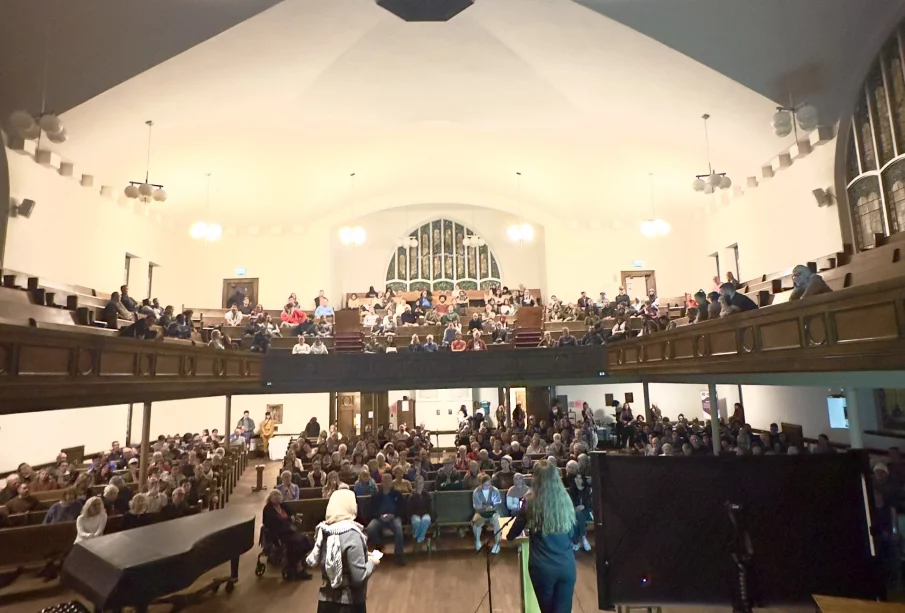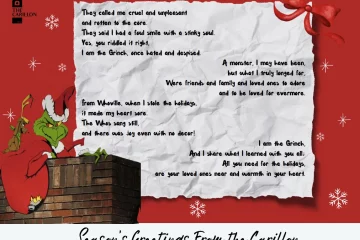Dr. Deirdre Nunan shared her account of the situation in Gaza on October 22, at the Knox-Metropolitan United Church
On Oct 22, 2025, the Eyewitness Report on Gaza event took place at the Konx-Metropolitan United Church, Regina. The event featured Dr. Deirdre Nunan, a Saskatchewan based orthopedic surgeon, as its prime and sole speaker. Dr. Nunan has worked in Gaza multiple times; both before and after Oct 7, 2023. Her most recent assignment was in July 2025, at the Al-Nasser hospital in Khan Younis.
The event was sponsored collectively by the Regina Public Interest Research Group, Doctors Against Genocide, Palestine Solidarity Regina, Amnesty International Saskatchewan, Regina Peace Council, Students for Justice in Palestine, Faculty for Palestine, and Regina’s Making Peace Vigil.
Eman Almehdawe, associate dean for graduate program at the University of Regina (UofR), emceed the event.
What Nunan witnessed
At the event, Nunan shared stories from her time in Gaza. She mentioned that 90 per cent of the patients she treated for gunshot wounds would tell her that they were shot while getting aid. She said she watched the emergency room doctors check the food distribution schedule online because after a few minutes of aid distribution the emergency room would be full of gunshot victims.
“They [gun-shot victims] usually told me it was at the American aid, which is what the people called GHF [Gaza Humanitarian Foundation], which is an American-Israeli organization that was created in the last year[…],” she said. “Dozens and dozens of people were shot when they went to a place where they were told to come to receive aid.” She shared that she treated patients who approached aid trucks near borders for flour to escape starvation but were run over, shot at, or both.
One of such patients was a 12-year-old boy named Ahmed, who was shot in leg while getting flour and had to crawl to get to the hospital. Later a group of men helped him. “I can’t help but think of the generosity of those men and what they sacrificed; to not get flour for themselves but to get Ahmed into a hospital,” said Nunan.
She recounted treating the same gunshot victims repeatedly, as infections often rendered initial treatments ineffective, forcing doctors to amputate body parts, when possible, to save their lives.
Reema, who was bombed in a refugee tent along with her family, was Nunan’s patient. Her body was covered with burns and tiny bits of accidentally made golf-sized molten misshaped metals that would tear through the patient’s body. Nunan removed one of such metal pieces from the body of a three-year-old girl.
She mentioned finding a few millimeters long metal pieces in the shape of a perfect cube which she thought seemed intentionally made. “I don’t know how [the metal cubes] would destroy infrastructure or some sort of a target. But I do know how it destroys human flesh, and it is all too efficient at doing that,” said Nunan.
These are the tents that are home to people who survived the genocide. And where children fly kites […] These kids and those kites are genocide survivors. – Dr. Deirdre Nunan
Lack of medical supplies
Talking about the lack of medical supplies, she recollected nurses hanging IV bags on the ceiling and patients lying on the stretchers, examination tables, beds made by putting two benches together, or on mats in tents because of lack of hospital beds.
After leaving Gaza, Nunan received videos from doctors she had worked with showing patients in “tent number 7.” She recalled there being only two tents when she left, highlighting the need for more tents for the growing number of people in need of care.
Nunan recalled meeting a Palestinian surgeon, Dr. Dawoud who had been sent to the Al-Nasser hospital. The previous hospital he was working at was not suitable to treat patients due to lack of electricity and very few medical resources because of airstrikes. Nunan mentioned two such hospitals; the Gaza European hospital where she had worked in 2024 and the Al-Shifa hospital. She said, “The first thing I was showing [Dr. Dawoud] was, which taps had water coming out of them.”
In her presentation, she also showed pictures of two wards of the Al-Nasser hospital which were destroyed by Israeli airstrikes. Nunan mentioned that the Al-Nasser hospital was overflowing with patients because of “the intentional destruction of health care and blockade on medical supplies.“
An unmatched resilience
According to Nunan, great value is put on education in Gaza culturally but prioritizing education in absence of an actual school is a daunting task. The schools are either destroyed or being used as shelters.
“You need many schools when half of the population is under the age 14 […] but none of those schools are schools anymore. Every single one that I saw was being used as a shelter, and every single one that I saw had some evidence of damage on it. Burn marks, bullet holes, holes from shells,” recalled Nunan.
Dr. Ahmed Muhanna, an anesthetist and director of the Al-Awda hospital, was one of the hostages who was released after the post-ceasefire agreement. Nunan worked alongside him in Jabalia, Northern Gaza. Ahmed was taken from his hospital in December 2023. Although Muhanna was in prison, his children’s education was not hindered, as their mother ensured their schooling was looked after.
Looking at a photo of Ahmed’s reunion with his family, Nunan said, “They are so much more grown up than when I last saw them. I haven’t seen this family since 2022. And under Dr. Ahmed’s wife’s careful guidance, those kids have been studying while he’s been in prison to make their father proud.”
Dr. Abdul Rauf, a Palestinian doctor and Nunan’s colleague congratulated the high school graduates with a heartfelt social media post but failed to mention in it that one of such graduates could have been his 16-year-old martyred son, Aymen, who was killed in an airstrike on their home.
After effects of Ceasefire
Nunan mentioned that on October 18, 2025, the Al-Nasser hospital staff treated more than a thousand patients. In their reports, they mentioned receiving the bodies of 15 dead Palestinians who were imprisoned.
According to a report in The Guardian, many of the 90 bodies of Palestinians returned to Gaza under the ceasefire deal showed signs of torture.
Doctors at the Al-Nasser hospital received the bodies without any identification. The hospitals in Gaza having been destroyed by bombs multiple times over the two years, any means of DNA identification was unavailable to them.
Talking about medical staff still in prisons, Nunan mentioned her friend Dr. Mohammad Obeid, a Palestinian orthopedic surgeon. Nunan mentioned working with him since 2019, and how she would consult him with many of her cases.
Nunan was just a few kilometers away in the Gaza European hospital in October 2024, when the Kamal Adwan hospital was invaded and Obeid was taken hostage.
Currently protests for returning the medical staff are taking place in Gaza. “If I could attend this protest in person, I would be holding up a sign for my friend, Dr. Muhammad Obeid,” said Nunan.
Hope still lives
Nunan insisted to find hope wherever one can. Looking at a photo of a refugee camp Nunan said, “These are the tents that are home to people who survived the genocide. And where children fly kites […] These kids and those kites are genocide survivors.”
At the end of her presentation, Nunan received a standing ovation from the crowd, an emotional acknowledgment of both her courage and the stories she carries.








